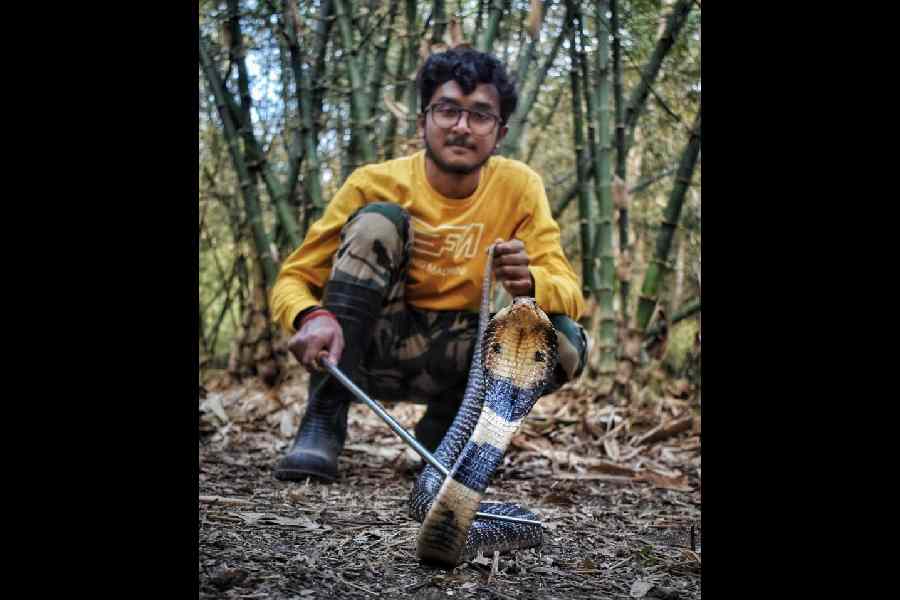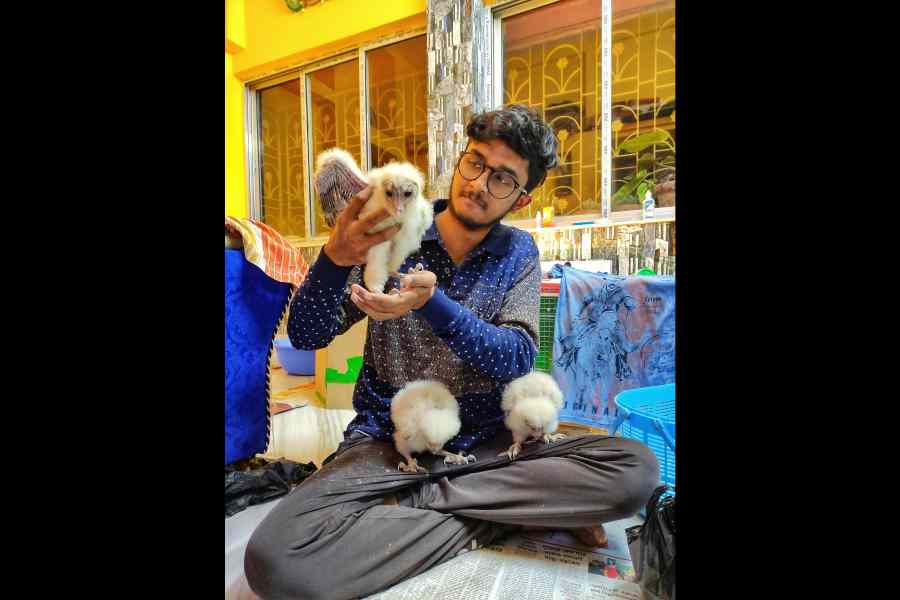There are six of them — Chitrak Pramanik, Sumonta Das, Raghunath Manna, Suman Pathak, Imon Dhara and Jhindan Pradhan. The oldest is 31 and the youngest 25. Their chosen area of work is rural Howrah, spanning Bagnan, Amta, Shyampur, Udaynarayanpur, Uluberia and Jagatballavpur blocks. And the work? I shall come to that eventually.
For now, know this: in the last five years or so, Chitrak has caught over 1,000 snakes, Raghunath and Suman have rescued 1,000 plus birds, Sumonta has rescued 100 wild cats, and Jhindan and Imon have jointly rescued over 1,200 turtles.
No, none of them works with the forest department. Sumonta works in a travel agency, Raghunath at a petrol pump, Suman is a contractual employee at a police station, Imon is in the business of selling ornamental fish, and Jhindan is doing her bachelor’s in education and is also a member of the Khalor gram panchayat. Pack leader Chitrak is an electrical engineer.

Photo courtesy: Chitrak Pramanik
The day I meet the group at Howrah’s Bagnan, around 55 kilometres from Calcutta, Chitrak is carrying a black spotted butterfly in a big plastic jar and three turtles in a bag. “We will release all of them in the jungle,” he says.
***
The jungle he is referring to is an expanse of green spread over 1,500 hectares. It has all kindsof trees — peepal, banyan, Indian almond, chestnut, tamarind, jackfruit, jamun, mango, acacia, Indian medlar, burflower, African tulip, coconut and palmyra. This is government-owned land. The nearest human habitation is at least three kilometres away. Continues Chitrak, “I released a leucistic common krait into the jungle some months ago. It is a white-coloured snake, very rare.”
Chitrak and his friends are trying to develop the “jungle” into a biodiversity hotspot. He says, “Rescuing one snake or a wild cat here and there is not our aim. Howrah is an industrial belt and development is happening. We are not against it, but there has to be a boundary beyond which the green zone should not be destroyed.”

It all started eight years ago when a fishing cat met with an accident. Says Chitrak, “I informed the forest department but they took some time to reach the spot. The department cannot be at our beck and call. But this incident was a wake-up call for me.”
From then on, Chitrak started attending workshops organised by the forest department. He learnt about biodiversity and its importance from Sourendu Sekhar Biswas, an environmental activist. Chitrak narrates a story he heard from him. “There was a time when Japan was hunting whales indiscriminately. There was a chain of reaction to this.
The population of krills — whales feed on them — increased rapidly. As a result, the algae — krills feed on them — that grows under the surface of ice in Antarctica and releases oxygen, reduced drastically. When scientists went to Antarctica on an expedition, they faced a shortage of oxygen.”

At a more functional level, he pored over books so he could distinguish between venomous and non-venomous snakes. He trained under herpetologist Anirban Chaudhuri. “He showed me how to use a stick and a catcher, how to maintain a safe distance from the reptile and how to bag it. One mistake and it will bite,” he says.
Four of the most poisonous snakes — monocled cobra, spectacled cobra, Russell’s viper and the common krait — are found here. While carrying out a rescue operation, Chitrak wears boots, gloves and glasses. “Some snakes spit poison. If it gets into your eyes, you could go blind.”
After five years of training, he became a certified snake rescuer in 2022.
In 2019, Suman was the first one to join Chitrak in his endeavours. “I used to accompany Chitrak whenever he went to rescue a bird or a wild cat. The job has its risks. We often have to take rabies shots. The other day when I was holding a turtle close to my arm, it bit me,” he says, smiling.
Jhindan is not afraid of turtle bites. She says, “They are to be found in large numbers here. Farmers sometimes dig up a few while tilling the land. They eat them too.” She continues, “Now that I am a member of the panchayat and work closely with them, I try to stop them. The good part is we have volunteers among the villagers who inform us whenever they find a turtle, a snake, an injured mongoose or a wild cat.”

Imon joined the team a year-and-a-half ago. He is documenting the birds one can see inthis jungle of theirs — Indian paradise flycatcher, black-naped monarch, changeable hawk eagle, honey buzzard...
We are walking around the forest area, when Raghunath tiptoes towards me and whispers, “There are two jackals approaching us.” I see them come up on the main path of the forest and then disappear into a bush. Next, they start howling. “They have got separated from their pack and are calling out to their mates,” translates Suman.
“This is nothing,” says Chitrak. “We come for herping at night with torchlights fixed on our foreheads. We search for snakes and other amphibians. The other day, I saw a Russell’s viper a few feet away. It did not attack us.” Adds Jhindan, “We have spotted porcupines. They often shed a spine or two. We collect them.”
No matter how much fun all of this sounds, Chitrak and company are doing serious work. Rajesh Mukherjee, who is a forest ranger of Howrah division, says, “Chitrak and his group act as a support system to the forest department.” He continues, “More often than not, information from remote areas does not reach us on time. But since they are locals, they get the information and reach the spot much before us. They are the first point of contact for the villagers. Chitrak not only rescues the animals but also keeps the villagers from panicking and attacking the animal unnecessarily.”
It is not just wildlife conservation, these young men double as rationalists. Says Chitrak, “When we go to schools or address public gatherings, we learn about myths, superstitions and misplaced notions about wild animals. For instance, some villagers believe a fishing cat can carry away a child. A few months ago, a pregnant wild cat was beaten to death.”
The group talks about how people get bitten when they try to feed snakes. “Snakes do not drink milk, no matter what our proverbs say,” says Chitrak. Jhindan says about how in her capacity as a panchayat member she has been trying to educate villagers about the importance of wildlife. For instance, the number of snakelets is increasing rapidly. Chitrak says, “I tell them it is because the food chain has been broken. If you kill and capture owls then who will eat the snakelets? It is either them or the eagles that feed on them.”
The “jungle” or forest zone is a long stretch along the Damodar river. According to Chitrak, the whole point of the effort isto create a space for wild animals. He says, “There is no doubt that human beings have encroached upon their lands. Much of the green cover has been destroyedin Bagnan. We are only trying to rebuild that.”
Chitrak explains how they drop seed bombs — seeds rolled into balls — in this zone during the rainy months, hoping that some of them will grow into trees, making the forest denser. They also distribute seeds among children. “If this space is declared a green zone or a protected biodiversity zone, more people will join us.”
***
On our way back, Chitrak and his friends stop to release the turtles in the Damodar. Jhindan too opens the lid of the jar containing the butterfly. Chitrak says, “The smallest of wildlife is key to the survival of human beings. If they are not here, we too will perish.”










